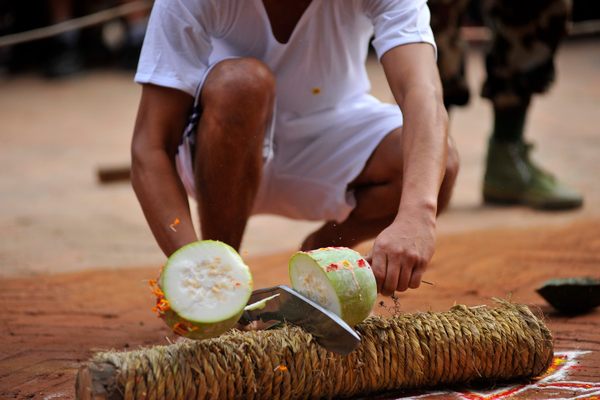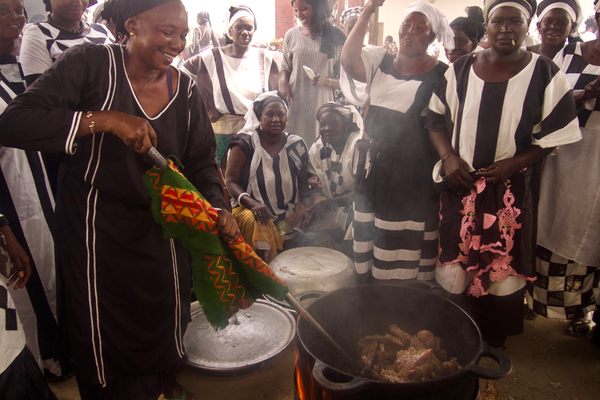The 1970s Movement to Reclaim Pretzels for God
“Pretzels for God” even took as its patron the first Native American saint.

In 1974, Marlene McCauley, a devout Catholic* and former circus performer, addressed the assembly at the 34th Annual Convention of the National Pretzel Bakers Institute. “God has been cast aside. The old immorality is now the new morality,” she told the gathered “pretzel men.”
In her speech, McCauley argued that America needed a potent religious symbol, something to rally Christians to rediscover prayer and penance. America, she believed, was in desperate need of the pretzel.
Only a year before, McCauley had launched Pretzels for God (PFG) from St. Francis Xavier Parish in Phoenix, Arizona. Under the impression that the pretzel had Christian origins, she and other members made the baked good the centerpiece in a movement to restore faith and commitment to God. They offered family-friendly activities and pretzel ceremonies, all under the auspices of a spiritual patron who would go on to be canonized as the first Native American saint.
With ancient origins in the Gaulish region of Europe that once spanned numerous modern-day nations, the pretzel is now firmly rooted in the baking traditions of German-speaking areas. From Bavaria’s lye pretzels to the Rhineland’s pudding pretzels, the baked good became a common everyday snack, as well as a festival food eaten during carnivals and on religious holidays such as Easter, Palm Sunday, and Lent.

According to the PFG, their movement was busily restoring the pretzel to its rightful place in the history of early Christianity. The food, many Christians believed, was not just rife with symbolism but had actually originated at the hands of a monk in a southern French monastery in 610 C.E. As legend has it, the long-ago monk folded leftover strips of dough to resemble arms crossed in prayer, and left three holes to represent the Holy Trinity. He then handed out to his creation to his pupils as a reward for learning their prayers.
Since pretzels are made with a simple recipe of flour, water and salt, European Christians in the Middle Ages ate them during the 40-day fast period of Lent when eggs and dairy were forbidden, writes Greg Dues in Catholic Customs and Traditions. During this period, the pretzel also began showing up in medieval religious art and prayer books, including an 11th-century depiction of the Last Supper and the 12th-century encyclopedia Hortus Deliciarum, compiled by the German nun Herrad of Landsberg.
But the PFG movement came at a time when the Catholic Church was at a crossroads. Profound changes in the Church, including the celebration of mass in vernacular languages instead of Latin, coincided with a growing trend towards secularism in American society. Congregants began leaving in ever greater numbers, with 7.5 million members no longer identifying with the Catholic Church in 1975. Many who remained faced a sense of insecurity about the institution and its role in their spiritual future.
Pretzels for God was a reaction against this mounting disillusionment, one that looked to a simple, tasty foodstuff to reinvigorate the faith of both young and old. The pretzel, claimed McCauley, would “be effective in helping put America in order.” For spiritual guidance, the PFG tapped Kateri Tekakwitha, a Catholic historical figure, as their pretzel patron. Tekakwitha had no relationship to the pretzel; it’s debatable whether the baked good had even reached the shores of the Americas by the time of her death in 1680.

Born in 1656 to an Algonquin mother and Mohawk father in what is now Auriesville, New York, Tekakwitha was among the first documented Native Americans to convert to Christianity. But while the PFG identified “the Lily of the Mohawks” as “a model of true peace in the world,” the choice to make her the patron of pretzels likely had less to do with the pretzel’s spiritual promise than it did with McCauley’s belief that her prayers to Tekakwitha had cured her young son’s severe hearing loss.
The association proved timely. Although the process for her beatification began in 1932, it wasn’t until 1980 when this major step towards sainthood was finally proclaimed by Pope John Paul II, just a few years after the heydey of Pretzels for God. (Five years later, McCauley even met the Pope in Rome and urged him to canonize Tekakwitha, giving him a taped performance of her traveling Kateri Tekakwitha-themed puppet show.)
With Tekakwitha watching over them, Pretzels for God propagated the Christian symbolism of the pretzel, emphasizing its value as a symbolic food to be eaten during Lent. They formed committees, posted articles in the bulletin of every diocese, and thoroughly courted the media. Groups organized pretzel bake sales and pretzel necklace workshops, after which believers would wear them as a symbol their faith. They pushed the pretzel as a Lenten food, and devised a “Ceremony of the Pretzel,” complete with a “pretzel prayer” for Ash Wednesday.
But the meaning of the pretzel hadn’t always been Christian. Food historian William Woys Weaver, who has heavily researched the baked good, says the pretzel’s Christian origins are fabricated. “There is no documentation whatsoever for the invention in 610 of the pretzel by a monk,” he says. The pretzel’s origins actually predate Christianity by hundreds of years. Their twisty shape is a symbol of Sirona, the Gaulish goddess of spring and the sacrificial rites associated with the harvest. While the PFG saw the Holy Trinity in the holes of the pretzel, Weaver says the pretzel’s form is “a votive symbol of a triplicate noose, the type used to hang three people at once, since three deaths were considered more potent than one.”

Despite the medieval reinterpretation of a pagan symbol into a Lenten one, the pretzel’s origin story was actually devised much later, according to Weaver. “This monk myth emerged during Prohibition to deflect the negative association of pretzels with beer, saloons, and bars, since it was a free snack given out to entice customers to buy beer or hard liquor,” he says. Though it’s unclear who originated the monk myth in the 1920s, Weaver notes that the National Pretzel Bakers Institute heavily promoted it during the mid-20th century, circulating the legend as fact in their magazine The Pretzel Baker and on television spots “complete with little statues of a monk.”
Though McCauley saw her beloved Kateri Tekakwitha canonized as the first Native American saint in 2012, the PFG was somewhat less successful. Just as suddenly as it had arrived on the scene, showing up in local news coverage from Minnesota to Pennsylvania, the PFG seemed to fade away. It’s survived today only by the Ash Wednesday Pretzel Prayer, which begins, “We beg you, O Lord, to bless these breads which are to remind us that Lent is a sacred season of penance and prayer.”
*Correction: A previous version of this article misstated the name of the founder of Pretzels for God as Maureen. It was Marlene. Also, she identified as Catholic. The Jesuits are a male religious order.
Gastro Obscura covers the world’s most wondrous food and drink.
Sign up for our email, delivered twice a week.





































Follow us on Twitter to get the latest on the world's hidden wonders.
Like us on Facebook to get the latest on the world's hidden wonders.
Follow us on Twitter Like us on Facebook